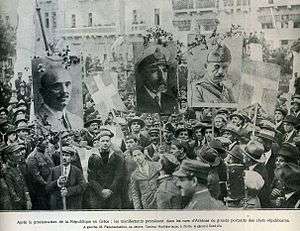Second Hellenic Republic
| Hellenic Republic | ||||||||||
| Ἑλληνικὴ Δημοκρατία Ellīnikī́ Dīmokratía | ||||||||||
| ||||||||||
| ||||||||||
| Anthem Hymn to Liberty Ὕμνος εἰς τὴν Ἐλευθερίαν | ||||||||||
.svg.png) Location of the Hellenic Republic (1935) in Europe. | ||||||||||
| Capital | Athens | |||||||||
| Languages | Greek | |||||||||
| Religion | Greek Orthodoxy | |||||||||
| Government | Parliamentary republic | |||||||||
| President | ||||||||||
| • | 1924–1926 | Pavlos Kountouriotis | ||||||||
| • | 1926 | Theodoros Pangalos | ||||||||
| • | 1926–1929 | Pavlos Kountouriotis | ||||||||
| • | 1929–1935 | Alexandros Zaimis | ||||||||
| Prime Minister | ||||||||||
| • | 1924 (first) | A. Papanastasiou | ||||||||
| • | 1933–1935 (last) | Panagis Tsaldaris | ||||||||
| Legislature | Parliament | |||||||||
| • | Upper Chamber | Senate | ||||||||
| • | Lower Chamber | Chamber of Deputies | ||||||||
| Historical era | Interwar period | |||||||||
| • | Republic proclaimed | 25 March 1924 | ||||||||
| • | Referendum (republic) | 13 April 1924 | ||||||||
| • | Pangalos dictatorship | 24 June 1925 | ||||||||
| • | Venizelos election victory | 5 July 1928 | ||||||||
| • | Venizelist coup attempt | March 1935 | ||||||||
| • | Kondylis coup | 10 October 1935 | ||||||||
| • | Referendum (monarchy) | 11 November 1935 | ||||||||
| • | 4th of August Regime | 4 August 1936 | ||||||||
| Currency | Drachma | |||||||||
| ||||||||||
The Second Hellenic Republic (Greek: Β΄ Ελληνική Δημοκρατία) is the historiographical term for the political regime of Greece between 1924 and 1935. It followed from the period of the constitutional monarchy under the monarchs of the House of Glücksburg, and lasted until its overthrow in a military coup d'état which restored the monarchy. The Second Republic marks the second period in modern Greek history where Greece was not headed by a king, with the assemblies and provisional governments of the Greek Revolution being regarded as the First Republic.
The Second Republic was proclaimed on 25 March 1924, in the aftermath of Greece's defeat by Turkey in the Asia Minor Campaign, which was widely blamed on the royalist government. During its brief existence, the Second Republic proved unstable. Greek society continued to be divided, as it was since the National Schism, between the pro-Republican Venizelists and the monarchists represented by the People's Party, who refused to acknowledge even the legitimacy of the Republic.
The cleavage in society extended to cultural and social issues such as differences over the use of Greek language to architectural styles. To this polarization was added the destabilizing involvement of the military in politics which resulted in several coups and attempted coups. The economy was in ruins following a decade of warfare and was unable to support the 1.5 million refugees from the population exchange with Turkey.
Despite the efforts of the reformist government of Eleftherios Venizelos in 1928–1932, the Great Depression had disastrous impact on Greece's economy. The electoral victory of the People's Party in 1933, and two failed Venizelist coups, paved the way to the restoration of the reign of King George II.
History

Part of a series on the |
|---|
| History of Greece |
 |
|
History by topic |
|
|
After the defeat of Greece by the Turkish National Movement (the "Asia Minor Disaster") of 1922, the defeated army revolted against the royal government. Under Venizelist officers like Nikolaos Plastiras and Stylianos Gonatas, King Constantine I was again forced to abdicate, and died in exile in 1923. His eldest son and successor, King George II, was soon after asked by the parliament to leave Greece so the nation could decide what form of government it should adopt. In a 1924 plebiscite, Greeks voted to create a republic. These events marked the culmination of a process that had begun in 1915 between King Constantine and his political nemesis, Eleftherios Venizelos.
The first President of the Hellenic Republic was Admiral Pavlos Kountouriotis, a supporter of Venizelos who resigned after a coup d'état in 1925. He was succeeded by the coup's leader, General Theodoros Pangalos, who was likewise deposed by the military five months later after embroiling Greece in the War of the Stray Dog. Kountouriotis was reinstated and reelected to the office in 1929, but was forced to resign for health reasons later that year. He was succeeded by Alexandros Zaimis, who served until the restoration of the monarchy in 1935.
Despite a period of stability and sense of well-being under the last government of Eleftherios Venizelos in 1928-1932, the effects of the Great Depression were severely felt, and political instability returned. As the prospect of the return of the monarchy became more likely, Venizelist officers launched a coup in March 1935, which was suppressed by General Georgios Kondylis. On October 10, 1935, the chiefs of the Armed Forces overthrew the government of Panagis Tsaldaris and forced President Zaimis to appoint Kondylis prime minister in his place. Later that day, Kondylis forced Zaimis himself to resign, declared himself regent and abolished the republic. A heavily rigged plebiscite occurred on 3 November which resulted in an implausible 98 percent supporting the return of the monarchy. King George II returned to Athens on 23 November, with Kondylis as prime minister.
See also
External links
- Hellenic Parliament - Constitutional History of Greece
- Greece during the Interwar Period, 1923-1940, from the Foundation of the Hellenic World
.svg.png)
.svg.png)